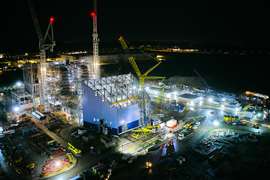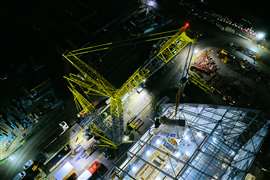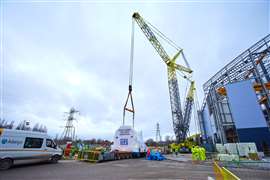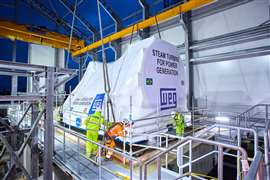Allelys goes through the roof
13 February 2024
 Spectacular night time view of the site with the turbine about to be lowered into position. Photo: Allelys
Spectacular night time view of the site with the turbine about to be lowered into position. Photo: Allelys
In a bid to minimise site disruption on a project in the UK, specialist Allelys used a crane to lower large and heavy components in through the roof of a building.
Allelys installed a turbine and a generator through the roof of the new turbine hall at a height of 22.3 metres. Largest of the two was the 160 tonne turbine measuring 7.8 x 5.35 x 4.6 metres (length, width, height). It arrived by ship at Goole docks in the north east of England where Allelys used its Liebherr LG 1550 lattice boom wheeled mobile crane to unload it. The crane positioned the turbine on stools for temporary storage.
When the site was ready to receive the turbine Allelys built a 24 axle girder frame trailer around it while it was still on the stools. It was then a case of raising it hydraulically to clear the stools so it could be transported around 33 miles (50 km) to Skelton Grange.
The Skelton Grange project is a combined heat and power waste to energy facility under construction on the south east side of Leeds. It will have the capacity to process 410,000 tonnes of waste into 49 MW of electricity.
 The Liebherr LG 1550 lattice boom wheeled crane lifting the turbine more than 22 metres in the air before lowering it into the building through the roof. Photo: Allelys
The Liebherr LG 1550 lattice boom wheeled crane lifting the turbine more than 22 metres in the air before lowering it into the building through the roof. Photo: Allelys
“Prior to the transport phase, Allelys completed route surveys and transport arrangement designs as well as swept path analysis for the journey through site. Our engineering reports identified two structures that required to be negotiated on site, Wyke Beck Bridge and Effluent Culvert,” explained Garnaud Tsika, Allelys commercial manager.
“Assessments were completed on both of these structures prior to project award. The assessments detailed that using a 16 axle girder frame, typical for the size and weight of this unit, wasn’t suitable, therefore we designed a solution to use a bigger and lighter frame to overcome these challenges, which enabled the route to be cleared,” Tsika continued.
Getting there
Along the route there was a night time closure of the A1 main highway so the central reservation between the carriageways could be opened up for the transport to pass through and join the M1 motorway. Space restrictions on site meant transferring the turbine from the girder frame onto 12 axle lines of self propelled modular transporter (SPMT).
 Preparations underway to lift the 160 tonne turbine from its SPMT. Photo: Allelys
Preparations underway to lift the 160 tonne turbine from its SPMT. Photo: Allelys
Once it arrived within the capacity radius of the 550 tonne capacity LG 1550 the crane lifted it into the turbine hall through a hole in the roof of the building.
A similar procedure was followed for the second component, a 96 tonne generator. It was temporarily stooled off before being transported, using the same 12 axle SPMT, to within reach of the crane for lifting.
“The turbine hall was still in construction and there was a number of restrictions we needed to adhere to, including the precise planning required to modify the crane location and position the outriggers due to non-load bearing areas,” Garnaud Tsika explained.
The 22.3 metre building height meant the LG 1550 was configured with a luffing jib.
Both components were carefully lifted and placed directly onto their final positions while the Allelys team negotiated the limited clearance.
 Precise placement was required on the foundation. Photo: Allelys
Precise placement was required on the foundation. Photo: Allelys
STAY CONNECTED


Receive the information you need when you need it through our world-leading magazines, newsletters and daily briefings.




